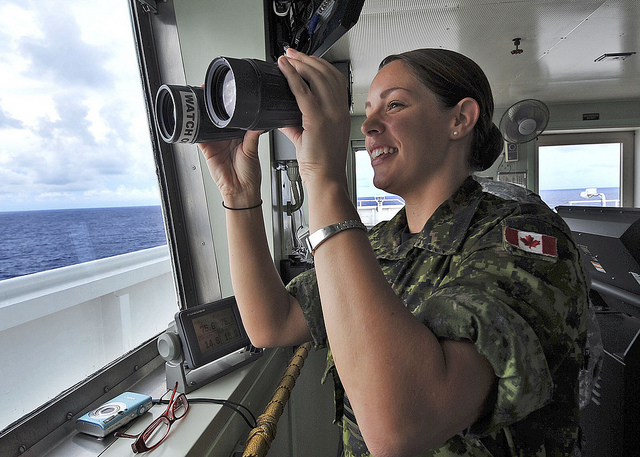
Canada has begun to play a more visible role at the Shangri-La Dialogue, and this year’s summit was no exception. Defence Minister Peter MacKay even very publicly broached the issue of
participating in the ASEAN Defence Ministers Meeting Plus (ADMM-Plus). In some ways, Canada’s request is understandable. Regular, high-level participation at Shangri-La is often seen as necessary for joining ADMM-Plus. As Peter Jennings noted in his recent
Strategist post on Canada in the Asia–Pacific, this request was also
politely rejected, a reminder that what might be necessary is not necessarily sufficient.
Part of this rejection arose from Canada’s often fleeting attention to the Asia–Pacific region itself. A good case in point is Prime Minister Brian Mulroney’s North Pacific Cooperative Security Dialogue, quickly shelved after only a few short years and raising well-placed
concerns about Canada's staying power (PDF). One can also add Canada’s equally brief funding for the track-two
South China Sea Dialogue in the 1990s.
Even Canada’s more regular, high-level appearances at Shangri-La were preceded by several years of relative inattention—a fact that regional leaders will remember when contemplating an invitation to ADMM-Plus, to say nothing of the East Asia Summit.
Yet this only tells part of the story. Equally important is what security role Canada could likely play in the region, and what capabilities it can bring. On that score, Canada will likely continue to face challenges in convincing its regional partners that it is now indeed a Pacific player.
Commentators have raised the possibility of a
reinvigorated effort at maritime diplomacy. Such an effort would be ideally suited in a region where most of the more serious disputes involve maritime powers, including the Taiwan Straits, the South China Sea, and the Senkaku/Diaoyu islands. It can include
maritime exercises, show the flag port calls, and even coast guard engagement (PDF)—though the Canadian navy’s role in many typically coast guard duties means naval diplomacy will continue to take centre stage.
Yet maritime diplomacy is also not a mission totally unfamiliar to the Royal Canadian Navy. After all, Canada’s navy has been pursuing a rolling five-year deployment pattern under WESTPLOY since 1995. This effort includes alternating naval visits to Northeast Asia and Southeast Asia and maritime exercises with the US Navy and other allied navies, including a
trilateral exercise involving American and Japanese naval ships in 2008.
Canada could certainly do more to expand its maritime ties to the region. First, it can further strengthen its already strong, highly interoperable ties with the US Navy. Second, it could seek to establish stronger naval cooperation with key regional allies, such as Japan, South Korea, and Australia, which could
strengthen the case for its inclusion on the ADMM-Plus’ maritime security working group (PDF). The latter choice could also be less intrusive, in so far as it avoids the perception that Canada is encroaching on the crucial bilateral ties regional countries have cultivated with the Americans.
Maritime diplomacy can also involve non-allied navies, such as the People’s Liberation Army’s Navy—whether in broad multinational exercises like Rim of the Pacific, with China finally assenting to take part at next year’s event, or smaller trilateral ones, as
recently recommended by Benjamin Schreer.
Yet the critical question is whether Canada has the military means to fulfill an expanded maritime role in the Pacific. A first step would be to reposition naval assets from Halifax to Esquimalt, and perhaps to expand its current plans for logistical support with Japan and Singapore to include some form of forward basing. Repositioning might be possible, though the fact that the RCN has traditionally favoured the Atlantic—and still has 55%of its assets there—does not make one sanguine on this outcome.
A more serious obstacle is the number of ships Canada can actually deploy. The RCN can boast a mid-sized blue-water fleet, consisting of 12 frigates, three destroyers, and three oiler replenishment ships. Yet only a portion of the RCN’s fleet can actually be deployed in the Pacific—though other ships can be temporarily surged into the theatre in the event of an emergency. Even with a 60:40 ratio favouring the Pacific (as the US Navy itself envisions by 2020), the RCN would only benefit from a relatively small increase in its regular force presence.
Long-term prospects for deepening maritime diplomacy are even bleaker, given
continued uncertainty about the RCN’s fleet replacement plans (PDF). It will be difficult enough for the RCN to even retain its current fleet structure for overseas operations under current budgetary conditions, in terms of number of hulls and even fleet displacement (if one excludes Arctic Offshore Patrol Ships designed largely for domestic duties).
Already, there are plans for fewer at-sea replenishment ships. The same could eventually be said for its future major surface combatant.
This is especially true if these vessels incorporate high-end capabilites, like the Aegis combat system for area air defence (PDF), increasingly seen as necessary for operations in high-threat, access-constrained environments, including the Western Pacific.
In the future, absent a highly skewed deployment pattern, the RCN will find it increasingly difficult to expand its naval activities in the Asia-Pacific. As a result, it might be unexpectedly difficult for Canada to either reinvigorate its regional maritime diplomacy, leverage such activities for a seat at ADMM-Plus, or simply to be seen as a regional player of any consequence. Maritime diplomacy, by itself, will continue to face long-term constraints and is unlikely to be a panacea. More will need to be done.
David S. McDonough is a SSHRC post-doctoral fellow in the Department of Political Science, University of British Colombia and a research fellow in the Centre for Foreign Policy Studies at Dalhousie University. Image courtesy of Flickr user PACOM.[7] maritime exercises, show the flag port calls, and even coast guard engagement: http://www.cigionline.org/sites/default/files/no25.pdf
[11] This is especially true if these vessels incorporate high-end capabilites, like the Aegis combat system for area air defence: http://www.davidsmcdonough.com/publications/commentaries-and-magazine-articles/the-us-pacific-pivot-and-implications-for-the-rcn/
[12] David S. McDonough: https://www.aspistrategist.org.auwww.davidsmcdonough.com
 Print This Post
Print This Post